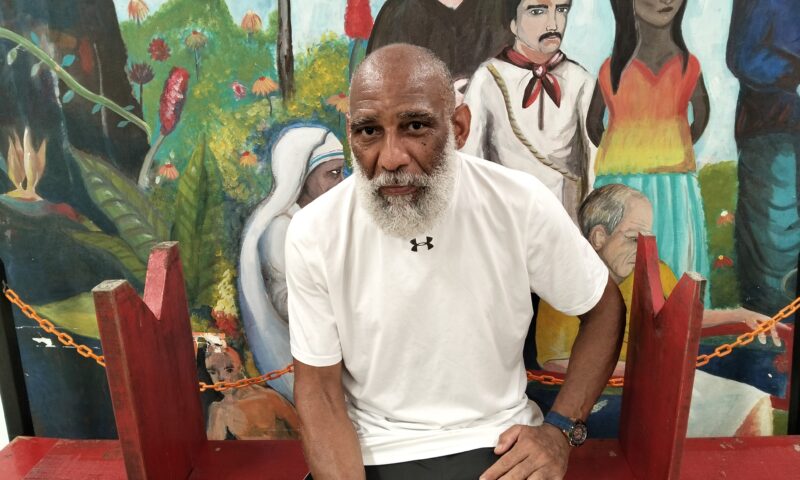When Mohamad presented his evidence about how the Taliban had tortured him because of his previous work in the Afghan government, a U.S. official found his story credible.
But the United States is still trying to deport him, just not to Afghanistan.
Mohamed spoke to Capital & Main from the Northwest ICE Processing Center in Tacoma, Washington, where he said he had been waiting almost half a year with no ability to pursue his case for protection or attempt to get released from immigration custody. He asked that he not be fully identified due to safety concerns.
“Nothing is clear for me,” Mohamad said through a Dari interpreter. “I don’t know what will happen to me.”
He said officials have told him that he might be deported to Costa Rica, Panama or El Salvador.
He is one of many asylum seekers who have been trying to navigate the increasingly opaque system that the Trump administration put in place in January to restrict access to protection for those who cross the border without permission. A district court judge in Washington on July 2 found that the Trump administration’s changes to the immigration system were unlawful and ordered the government to process people who are still in the U.S. through the full asylum process.
That could mean that Mohamad’s case will finally move forward in a way that allows him to present his evidence to an immigration judge.
Mohamad had been waiting in Mexico City in January, trying to get an appointment to request asylum through a phone application called CBP One, when President Donald Trump took office.
On his first day in office, Trump canceled all CBP One appointments and closed down the application process, which the Biden administration had created to receive asylum seekers at ports of entry.
Four days later, Mohamad, believing that the United States was the safest place for him to go after the Taliban had tortured him, made his way to the Arizona border and crossed onto U.S. soil to request protection. He has been in limbo in U.S. immigration custody since then.
The administration suspended the ability to apply for asylum, but people could still request a lesser-known protection under the United Nations Convention Against Torture and Other Cruel, Inhuman or Degrading Treatment or Punishment, known as the Convention Against Torture or CAT. Instead of following the previously established screening process for protection under the convention, the Trump administration created a more difficult legal assessment, according to multiple immigration attorneys whose clients went through the process.
Under the old process, people seeking protection under the Convention Against Torture went through initial screenings, known as reasonable fear interviews, which assessed whether there was a reasonable possibility that they would be tortured. Those who passed the screenings went on to immigration court, where they had time to gather more evidence and find attorneys to help them prove to a judge that they were more likely than not to be tortured if returned to their country, the legal standard to win final approval for protection under the convention.
But under Trump’s new system, that more-likely-than-not legal standard moved from the final step in the process to the initial screening, requiring a higher level of evidence with less time to gather or show it.
A report from Human Rights First found that the Department of Homeland Security conducted the assessment for some migrants who express fear of returning home, but it deported others without screening them at all.
“It feels very arbitrary of what happens to each person, and there’s really no record,” said Natalie Cadwalader-Schultheis, a senior staff attorney with Human Rights First. “No paper record, no witness, no administrative judge or federal judiciary judge who’s able to review what’s going on. It’s very secretive and very opaque.”
When asked about the process, the Department of Homeland Security responded through an unnamed spokesperson that U.S. Citizenship and Immigration Services does not assess for persecution concerns based on protected grounds — what would typically be assessed in initial screenings for asylum. The spokesperson also said that the officer assesses for fear of torture in the country of origin if that’s the planned deportation destination.
None of the agencies within the department involved in the process — Immigration and Customs Enforcement, Customs and Border Protection and U.S. Citizenship and Immigration Services — responded to the request for comment from Capital & Main.
Many people fleeing legitimate fears of harm have failed the stricter assessment, including a woman from Ethiopia who was previously tortured there after witnessing government officials commit extrajudicial killings.
“They found that our client was detained and beaten by the Ethiopian government but still found that she had no right to go into removal hearings to apply for CAT relief,” said attorney Ginger Jacobs. “She didn’t rise to the standard even though she’d already been tortured by her government, and they found her credible.”
Attorneys are not allowed to be present for the Convention Against Torture assessment interviews, Jacobs said — another change under the Trump administration from prior practices for reasonable fear interviews.
Jacobs said that the new assessments, though requiring more evidence to reach the high legal standard, are generally shorter than the old interviews as well.
“They just created this whole process out of whole cloth,” said Tim Warden-Hertz, the directing attorney at Northwest Immigrant Rights Project and the lawyer representing Mohamad. “It’s a ridiculous process.”
Despite the obstacles, Mohamad managed to pass the assessment after more than a month in custody.
He told the officer about how the Taliban had used electric shocks on him.
“Still I have nightmares in my dreams that the Taliban is torturing me or killing me,” he told Capital & Main.
The form from U.S. Citizenship and Immigration Services detailing Mohamad’s results is less than a page long, another change from the previous process.
Results from reasonable fear interviews would typically include a multi-page summary of the conversation between the asylum officer and potential refugee, but Mohamad’s assessment notice does not.
“You were interviewed by a DHS asylum officer to determine whether it is more likely than not that you will be tortured in Afghanistan,” the form says, using the abbreviation for the Department of Homeland Security. “The assessment made by the DHS asylum officer, indicated below, will be considered by DHS in determining whether you may be sent to Afghanistan. DHS will provide you with additional information regarding how you will be processed.”
Below the statement, the officer checked a box, indicating that Mohamad had established that he would be tortured. The form has no place for a signature.
The Department of Homeland Security appears to have updated the form since then based on a document given to a detainee who went through the assessment more than a month after Mohamad. The newer version adds a place for a short notes summary and analysis from the asylum officer as well as signatures from the officer and a supervisor.
ICE has already deported many who failed the assessment, including several of Cadwalader-Schultheis’ clients. It’s not yet clear what may come out of the Washington court case for people whom ICE has already deported. Judge Randolph D. Moss ordered further briefings on the issue.
The attorney said police in her client’s home country detained and questioned them, and the officers told them that they couldn’t leave the city they were in after ICE deported them.
“It’s very clear to me that they had a very legitimate claim, and they’re paying the price for it now,” Cadwalader-Schultheis said. “The country that was looking for them has them because they were deported without any process.”
Another client chose deportation, she said, after his wife didn’t pass the assessment even though he did. The client couldn’t stand the thought of his wife facing danger back in their home country alone, she said.
“The United States is not a safe country — it’s not a safe country to seek asylum,” Cadwalader-Schultheis said, “and our country is not this leader or this beacon of everything that is inscribed on the Statue of Liberty.”
She has one client who made it into immigration court proceedings after passing the assessment and another who, like Mohamad, passed but still hasn’t gotten the opportunity to see a judge and pursue a claim for protection, she said.
“Are there actual rules?” Cadwalader-Schultheis said. “If there are, I know what to do as a lawyer to try to help. And, if there aren’t any rules and they’re just going to do whatever they want, I can’t tell if what I’m doing is making a difference or am I spinning my wheels because the government is going to do whatever it wants anyway.”
Mohamad said that while he’s stuck in limbo, the most painful part is worrying about his children. They and his wife are living in hiding, he said, and his children are unable to attend school.
“They were the [top] grade in the class,” Mohamad said, weeping as he spoke. “And when there was a competition between the schools, they were always the first or second. But now after the Taliban took over Afghanistan, they have no school.”
Because of the situation, he had not been able to communicate with his children, he said.
Copyright 2025 Capital & Main


 StrandedNovember 25, 2025
StrandedNovember 25, 2025
 Column - State of InequalityNovember 28, 2025
Column - State of InequalityNovember 28, 2025
 The SlickNovember 24, 2025
The SlickNovember 24, 2025
 Striking BackDecember 4, 2025
Striking BackDecember 4, 2025
 Latest NewsDecember 8, 2025
Latest NewsDecember 8, 2025
 Latest NewsNovember 26, 2025
Latest NewsNovember 26, 2025
 The SlickDecember 2, 2025
The SlickDecember 2, 2025
 Latest NewsDecember 1, 2025
Latest NewsDecember 1, 2025

